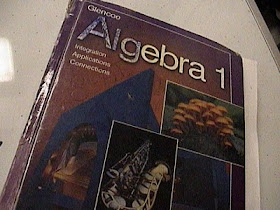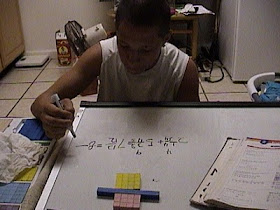
The text book one of my students uses. Currently he is doing fractions...and has a test that we were studying for. This is quite common even up to the college level, reviewing fractions because the students forget the rules. I would prefer to teach fractions using algebra but in this case we don't have the time it takes to develop the concepts...I had one hour. So I used the 5 basic concepts
to bring home the point that the rules did not change we can't add the numbers unless they are SAME. And Pointed out the numbers have two parts the "how many" part and the "what kind" part. With fractions the numerator tells how many and the denominator (de nome of it) tells what kind. Have to be the same KIND before we can add.

So basically we did an hour on "fractions". Here we are adding two mixed numbers. We talked a lot about multiplying by 1 and that "one" could be 2/2, 3/3 etc. And how numbers have to be same before we can add, subtract or divide them. Felt sorry for him because we had to spend an hour basically on fractions by himself. It would have been more fun if he had another student there and we could mix it up and actually do some algebra but we didn't have time. He did say he didn't mind because "you have a way of explaining it that's easy and kinda fun, my teacher makes it confusing and hard."
That's because his teacher is teaching the same way we have been teaching for decades, never mind that it doesn't work, using rules and memorization instead of concepts and algorithms based on those concepts. He teaches the way he was taught to teach...so all the way to college, students forget what they learned in 4th grade about fractions. If we taught English this way nobody would speak the freaking language...and math is a language why not teach it that way?

Rather than convert the mixed numbers into improper fractions, I showed him how to add and subtract using the associative property of addition. I didn't tell him that; we just "added up the parts." First the whole numbers then the fractions...if the fractions ended up being improper we just added one to the whole number...7 1/2 + 6 3/4 for example. 7 + 6 = 13 then 1/2 + 3/4 = 5/4 so 13 + 5/4 = 14 1/4.
"Wow! That's easier."
7 3/8 + 9 1/4 = 7 + 9 + 3/8 + 2/8 = the easy way.
59/8 + 72/8 = the hard way.
We had to go over common denominators, equivalent fractions, and improper fractions. It was not tremendous fun but he did enjoy it because he knew he was going to ace the test, now that he understood "what the hell he was doing."
Note how the blocks are set up to show that 3/4=6/8=9/12=12/16.
I keep threatening to build a fractions page at Crewton Ramone's House of Math...but so far I haven't.
And BTW if you are on Maui, or anywhere on the planet for that matter I can do tutoring with you.
No comments:
Post a Comment